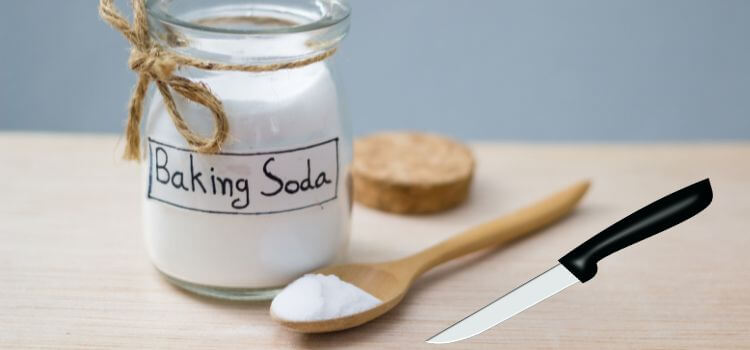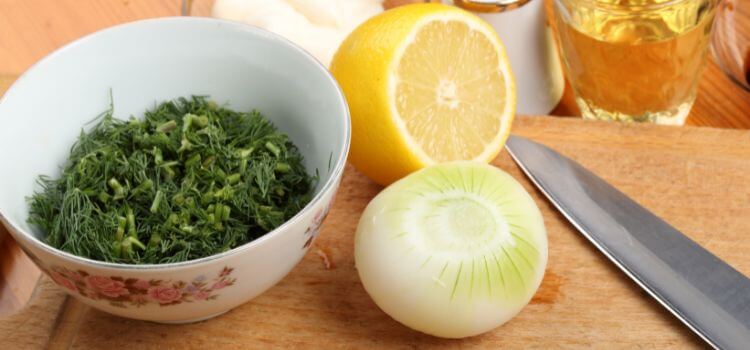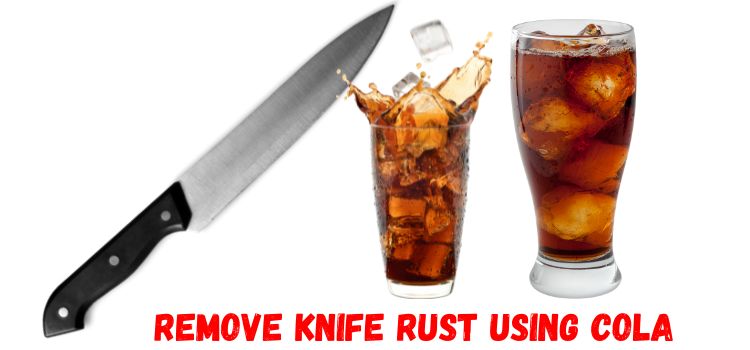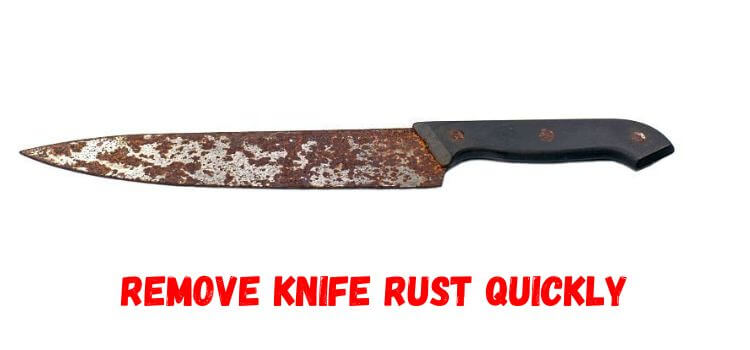As an Amazon Associate, I earn from qualifying purchases
Are you facing the common issue of rust on your knives? Fear not! We’ve all been there. It’s not just a blemish on the metal; it also affects the knife’s performance. So, let’s dive right in and see how to remove rust from a knife.
What Causes Knife Rust?

The primary cause of rust on a knife is the reaction of iron, a steel component, with oxygen in the presence of water or moisture. This process is known as oxidation and results in the formation of iron oxide, commonly known as rust. Some Certain conditions and substances can accelerate this rusting process:
Water and Humidity: Extended exposure to water or humid environments can cause a knife to rust. That’s why it’s crucial to dry knives thoroughly after washing.
Salt: Salt, especially sea salt, can speed up corrosion due to its electrolytic properties.
Acidic Substances: Acids can corrode the metal, leading to rust. That’s why knives cutting fruits or other acidic foods should be cleaned promptly.
Is Rust on Knives Dangerous?
While rust isn’t typically harmful to touch or see, it can pose a risk in specific circumstances. If a rusty knife were to cause a deep wound, there could be a risk of tetanus, an infection caused by bacteria entering the body through a cut or puncture. However, this scenario is relatively rare.
Additionally, rust can contaminate food during preparation, impacting the food’s taste and safety.
How to Prevent Rust in the First Place?
Rust prevention is a matter of proper care and maintenance. Here are some key steps to take:
Clean Your Knives Regularly: Clean your knives as soon as you’re done using them. This is especially important if used on acidic foods, which can expedite the rusting process.
Dry Your Knives Thoroughly: Since moisture is a key factor in rust formation, ensure your knives are completely dry before storing them.
Oil Your Knives: Regularly oiling your knives creates a barrier against moisture and oxygen, thus preventing rust.
Store Your Knives Correctly: Store your knives in a dry, cool place. Knife blocks, magnetic holders, or specialized knife cases are excellent.
Regular Maintenance: Regularly inspect your knives for any early signs of rust and remove them promptly to prevent minor rust spots from becoming a more significant issue.
Remember, taking good care of your knives extends their lifespan and maintains their performance and aesthetic appeal.
How to Remove Rust From a Knife (The Best Method)
When removing rust from a knife, numerous methods are available. However, one of the most influential and readily accessible methods involves using something you probably already have in your kitchen – Baking Soda.

Remove Rust With Baking Soda
Sodium Bicarbonate is Baking soda’s other name. It is a mild abrasive that can gently scrub away the rust while being gentle enough not to scratch the knife’s surface. It’s also a base that neutralizes the acid in the rust, helping dissolve it.
Material You Will Need:
Removing Process
Make a Baking Soda Paste: Fill your bowl with a thick paste by combining a few teaspoons of baking soda with some water.
Apply the Paste: Using your fingers or a cloth, apply the baking soda paste directly to the rusted areas of the knife. Make sure the rusted areas are completely covered.
Let It Sit: Spend ten to fifteen minutes, letting the paste settle on the knife. As a result, the rust and baking soda have time to react.
Scrub the Knife: Use your old toothbrush or soft scrubbing brush to gently scrub the rusted areas after letting the paste sit. The rust should start to lift away.
Rinse and Repeat: Rinse the knife under warm water, drying it thoroughly afterward. If there’s still rust, repeat the process until it’s all gone.
Oil the Knife: After you’ve removed all the rust and the knife is dry, apply a little bit of lubricating oil. This creates a protective barrier and helps prevent future rusting.
How to Remove Rust From a Knife? (Alternatives Homemade Rust Removers)
While baking soda is a fantastic rust remover, there are several other household items that you can use to tackle this common issue. Let’s explore some of these methods and how to implement them.
Remove Rust With White Vinegar
White vinegar is an excellent solution due to its mild acidity.
Materials Needed:
Method:
Remove Rust With Lemon and Salt

The acid in the lemon and the abrasiveness of the salt work well together to remove rust.
Materials Needed:
Method:
Remove Rust With Dish Soap And a Salted Potato
It might sound strange, but the oxalic acid in the potato reacts with the rust, helping to remove it.
Materials Needed:
Method:
Remove Rust With Citric Acid
Citric acid is a potent rust remover.
Materials Needed:
Method:
Remove Rust With Aluminum Foil
Aluminum foil is another gentle but effective rust remover.
Materials Needed:
Method:
Remove Rust With Cola

The phosphoric acid in cola can help dissolve rust.
Materials Needed:
Method:
Another Rusty method
Removing Rust with Whetstone Rust Eraser
A Whetstone Rust Eraser is designed to remove rust from blades.
Polishing with Abrasives
To get rid of rust, you may also use abrasives like sandpaper.
Always remember to take safety precautions when handling knives and other sharp objects. If the rust is very deep or the knife is valuable or sentimental, consider professional restoration to avoid potentially causing more damage.
What is the Easiest Way to Remove Rust Quickly?
While all the above methods can effectively remove rust, baking soda is usually the quickest if you’re in a hurry and want a quick fix. Baking soda paste can start dissolving rust within minutes. Remember to have patience, though. Complete removal may take some time, depending on the rust’s extent.

What Oil Do You Use for Knives?
The type of oil used for knives can depend on the knife’s purpose. Food-safe mineral oil is typically the best choice for kitchen knives as it’s odorless, tasteless, and safe to consume in small amounts.
You can consider other types of oils for knives that aren’t used for food preparation. Some popular choices include:
3-in-1 oil: This lightweight mineral oil is good for preventing rust.
Machine oil: This oil is often used on machinery and tools but can also work well for knives.
Honing oil: This oil is used explicitly for sharpening stones during knife sharpening.
Tung or Linseed oil: These are more traditional oils used for knife maintenance, especially for the handle.
Regardless of the type of oil you choose, the most important thing is ensuring the knife is clean and dry before application. A thin layer of oil should be enough to protect the blade from moisture and oxygen, the two primary culprits of rust.
Conclusion
In conclusion, learning how to remove rust from a knife can be done without professional expertise or expensive tools. You can restore your knives to their former glory with simple household items like baking soda, white vinegar, or a potato. By understanding what causes rust and how to prevent it, you can extend your knife’s lifespan and maintain its performance. Remember, patience and regular maintenance are key. Whether a cooking enthusiast or a professional chef, a well-cared-for, rust-free knife is an invaluable tool in your culinary arsenal.
FAQs
Absolutely! Rusty knives can be salvaged using baking soda, vinegar, or lemon. Removing rust and regular maintenance can prolong a knife’s lifespan and keep it in good working condition.
Baking soda paste applied to the rusted area of a knife is an efficient and fast rust remover. After a few minutes of application, you can scrub off the rust, rinse, and dry the knife.
Japanese knives often rust because they’re typically made of high-carbon steel, which is prone to oxidation when exposed to moisture and air. Proper care, including prompt cleaning and drying, can prevent rust.
Proper knife cleaning involves washing the knife with warm soapy water, then drying it thoroughly. Avoid soaking or leaving the knife wet, as this can cause rust. Regular oiling also helps maintain the blade.
Your knife is rusting due to exposure to moisture and oxygen, which causes oxidation on the metal surface. This is common with knives made from carbon steel. Proper cleaning, drying, and oiling can prevent rust formation.
Leave a Reply